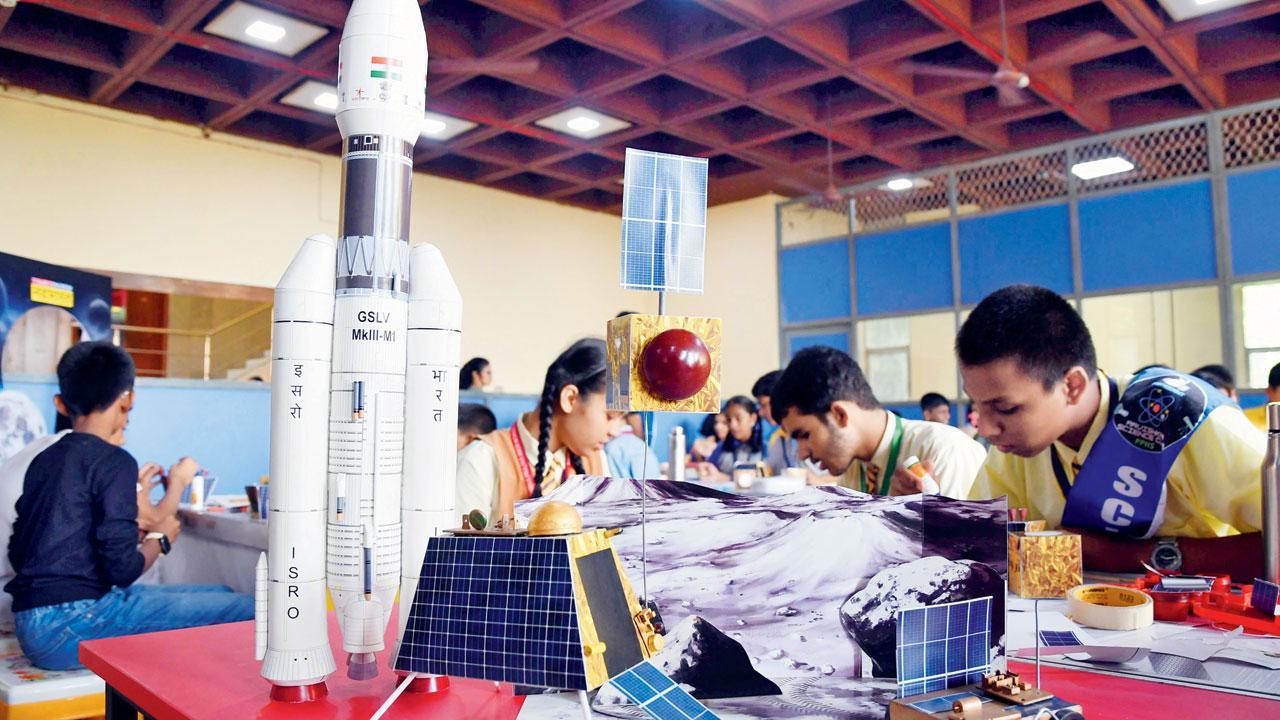Expert talks why landing on moon is important; water on the South Pole and interest revival in lunar missions

Crafting Chandrayaan-3 model workshop. Pics/Ashish Raje
Many kilometres away from the Indian Space Research Organisation (ISRO) in Bengaluru, young hearts beat excitedly at the prospect of the ticking clock with just a few hours to go for Chandrayaan-3 moon mission.
ADVERTISEMENT
Clock ticks
The response for Nehru Science Centre’s (Worli) make a Chandrayaan-3 paper model workshop, underway at the Centre’s hall above the auditorium, was robust. Students were busy crafting paper models of Chandrayaan-3, on Wednesday afternoon. They were gung-ho before the descent, shouting “yes, yes, of course,” when asked if they thought there would be a successful landing.
The excitement built up and it was house full at the Centre’s auditorium much before time, as Professor Mayank N Vahia, former scientist, Tata Institute of Fundamental Research (TIFR) Mumbai arrived for an interactive session a little before the Chandrayaan-3 live-steaming.
Professor Vahia struck a chord with the audience with his easy- going style. The expert started off with some informal interaction, asking his audience for some initial questions since he was a little early for the formal presentation.
To a question about why it was important for a nation to go to the moon, Vahia said, “There are a number of factors. One is prestige. The other is the challenge and then, there is the fact that the earth is running out of resources. At some stage, the moon is going to get colonised. It will be available for mining, for space travel… so it is important to have gone there.”
To a question from a youngster in the audience, about why it is so difficult to land on the moon, Vahia had a relatable analogy, “it is easier to drive in Mumbai than drive in the Himalayas. It is tough because the surface is very rough and the lander needs to be very careful to land between the mountains, there are many mountains, many hazards, it is perilous.”
The professor stressed that the most precious resource, water is seen near the South Pole of the moon. “That is the prime reason why we are going to the moon. Water is critical to everything, to life itself. That is why there is a mad rush to be near the South Pole of the moon.”
Interest peaks
Professor Vahia then formally introduced himself to cheers and explained the moon mission with the help of a slide show. After stating that he had worked at the TIFR for 40 years and his expertise was making telescopes, he said in his talk, while waiting for the live-streaming of the Chandrayaan 3 mission that, “the next mission to the moon is going to be an Indo-Japanese collaboration. India needs to develop rockets that can take a larger payload.”
Through the help of a slide, Vahia explained the timeline of moon missions, stating, “There was a drop in the middle but again from 2000 onwards we see moon missions picking up, now we see a burst of interest.”
J Worner, former director general, European Space Agency, had stated that he had an intention, “to build a permanent base station on the moon. An open station, for different member states, for different states around the globe.” He liked to call that vision a, “moon village”.
Vahia added that, “there is definitely a desire to set up rocket manufacturing units on the moon sending these on missions to different planets…” By then, the live-streaming of the descent had started in the auditorium and the expert too became the audience and watched. A restless auditorium burst into applause at different junctures as commentators spoke about the lander getting closer to the surface.
Two children stood up holding the tricolour all of a sudden, as cameras clicked wildly. As the lander got even closer, with the altitude dropping, shouts of ‘Bharat Mata ki Jai’ reverberated. And then, it was all drowned out in Vande Mataram, and thunderous applause as the lander touched down. People started congratulating each other, and fists pumped through the air. Exiting the Centre, one could hear ‘dhol’ in the air.
A cabbie saw triumphant crowds pour out from the Centre and asked in Hindi, “Ho gaya? Pahunch gaye chaand pe? (Have we reached the moon), while another cabbie exclaimed next to him, “Yes, yes, hear the dhol? looks like. Anyway, what difference to us? We have to drive here only, maybe our grandchildren will drive on the moon one day,” he laughed.
2,000
Year when moon missions began picking up
 Subscribe today by clicking the link and stay updated with the latest news!" Click here!
Subscribe today by clicking the link and stay updated with the latest news!" Click here!







